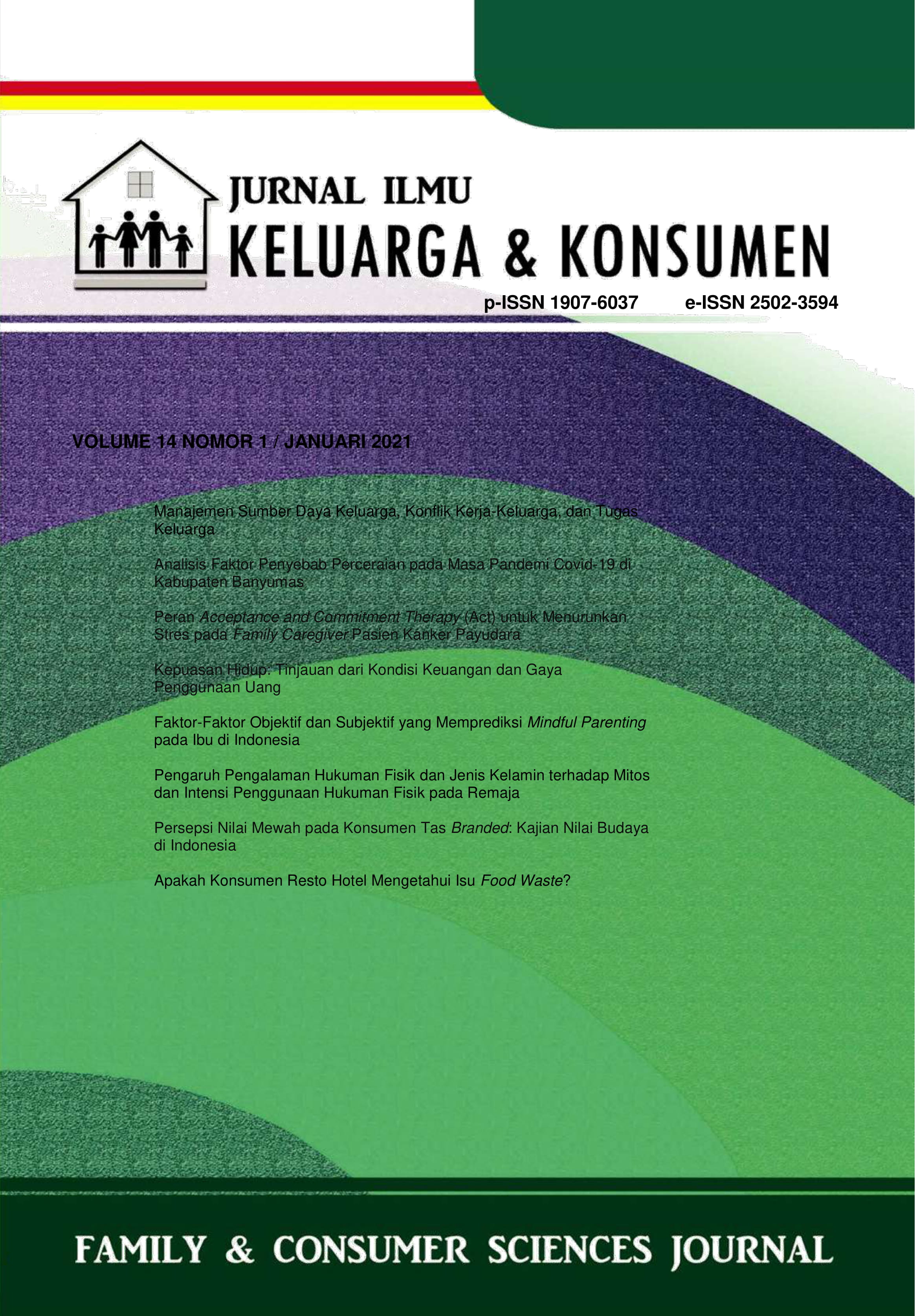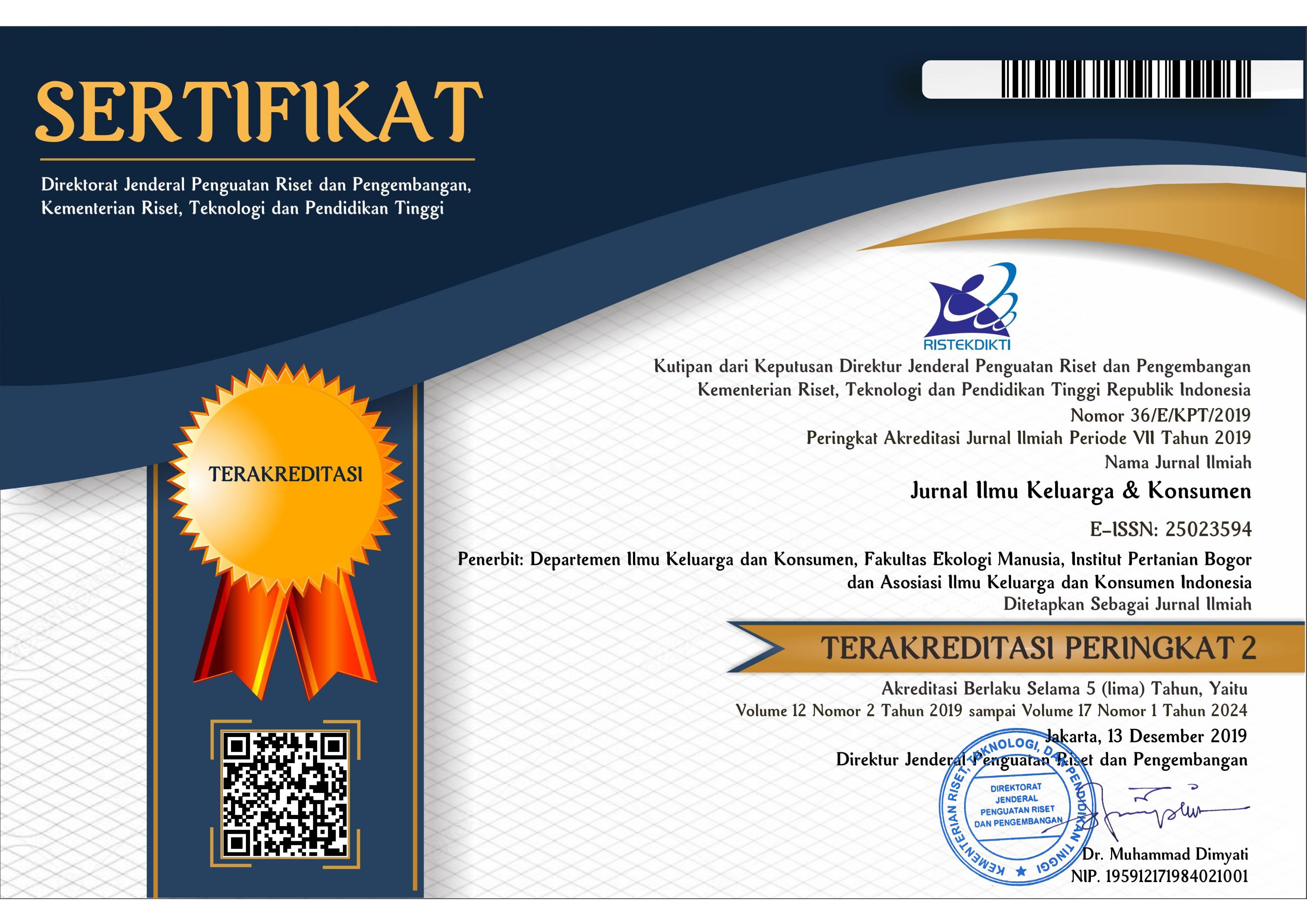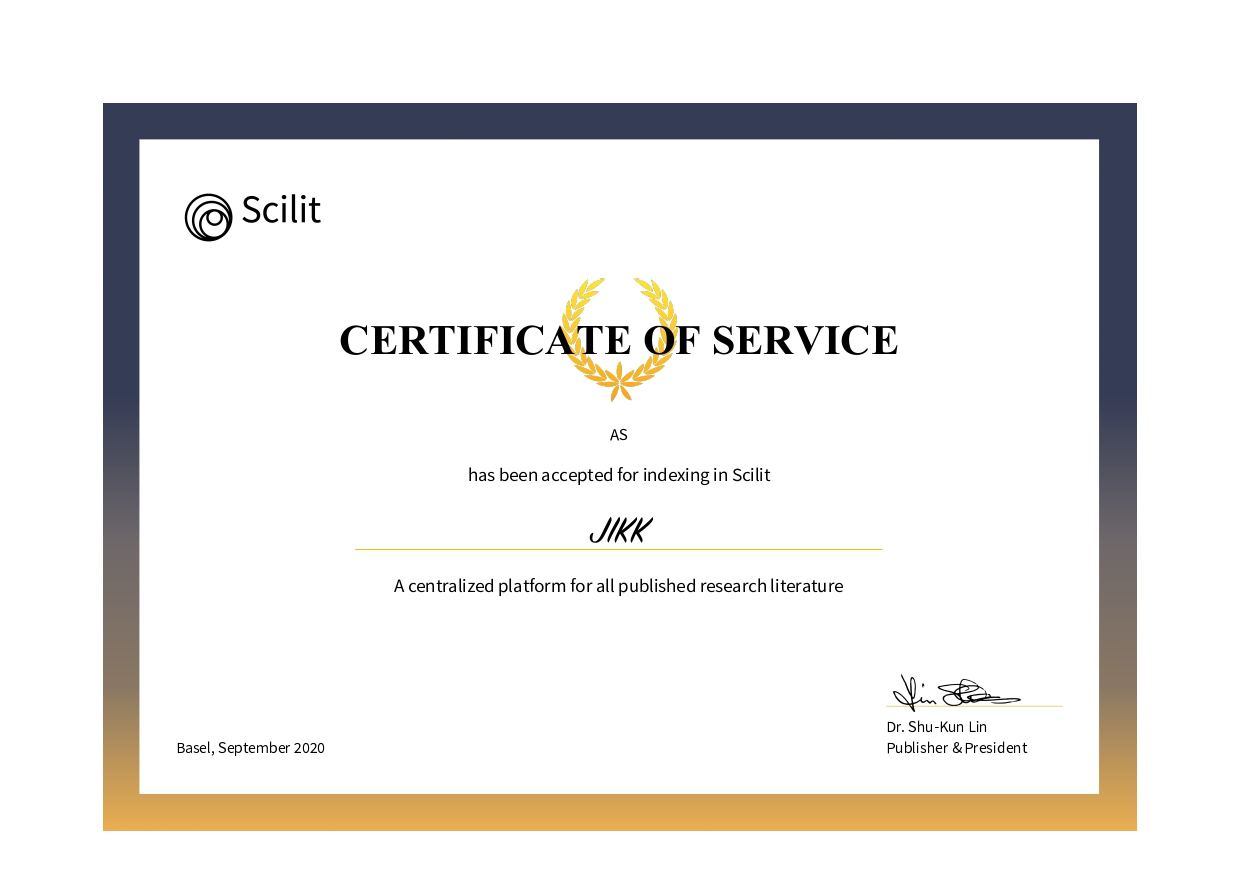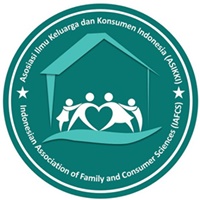PENGARUH PENGALAMAN HUKUMAN FISIK DAN JENIS KELAMIN TERHADAP MITOS DAN INTENSI PENGGUNAAN HUKUMAN FISIK PADA REMAJA
Abstract
Banyak orang tua memercayai hukuman fisik tepat digunakan sebagai strategi yang efektif untuk mendisiplinkan anak sehingga membuat siklus penerapan hukuman fisik tidak terputus pada generasi selanjutnya. Penelitian ini bertujuan untuk menganalisis pengaruh pengalaman menerima hukuman fisik dan perbedaan jenis kelamin terhadap penerimaan mitos dan intensi menggunakan hukuman fisik pada remaja. Penelitian ini menggunakan pendekatan kuantitatif dengan teknik purposive sampling yang melibatkan 123 remaja berusia 13-17 tahun dengan status sosial ekonomi menengah ke bawah dan berdomisili di Jawa Barat. Pengalaman hukuman fisik diukur menggunakan Parent-Child Conflict Tactic Scale (CTSPC) dan penerimaan mitos hukuman fisik diukur menggunakan Corporal Punishment Myth Scale (CPMS). Uji analisis jalur menunjukkan bahwa perbedaan jenis kelamin secara signifikan (β=-5,306; p<0,05) berpengaruh pada penerimaan mitos hukuman fisik dengan hasil remaja laki-laki memiliki penerimaan mitos hukuman fisik yang lebih tinggi dibandingkan remaja perempuan. Sedangkan pengalaman hukuman fisik tidak memengaruhi penerimaan mitos hukuman fisik pada remaja. Hasil analisis jalur juga menunjukkan bahwa mitos hukuman fisik berpengaruh terhadap intensi penggunaan hukuman fisik. Hasil penelitian dapat digunakan untuk memahami alasan tidak terputusnya siklus hukuman fisik dan dapat membantu praktisi dalam pembuatan modul parenting terkait strategi disiplin.
References
Bandura, A. (1986). Social foundations of thought and action: A social cognitive theory. Englewood Cliffs, NJ: Prentice Hall.
Bartlett, J. D., & Easterbrooks, M. A. (2012). Links between physical abuse in childhood and child neglect among adolescent mothers. Children and Youth Services Review, 34(11), 2164–2169. doi:10.1016/j.childyouth.2012.07.011.
Bell, T., & Romano, E. (2012). Opinions about child corporal punishment and influencing factors. Journal of Interpersonal Violence, 27(11), 2208–2229. doi:10.1177/0886260511432154.
Bornstein, M. H. (2013). Parenting and child mental health: A cross-cultural perspective. World Psychiatry, 12(3), 258-265. doi:10.1002/wps.20071.
Breen, A., Daniels, K., & Tomlinson, M. (2015). Children’s experiences of corporal punishment: A qualitative study in an urban township of South Africa. Child Abuse Negl., 48, 131-139. doi:10.1016/j.chiabu.2015.04.022.
Chiocca, E. M. (2017). American parents’ attitudes and beliefs about corporal punishment: An integrative literature review. Journal of Pediatric Health Care, 31(3), 372–383. doi:10.1016/j.pedhc .2017.01.002.
Choi, S., Yoo, J., Park, J., Lee, H., Tran, H. T. G., Lee, J., & Oh, J. (2018). Manifestations of socioeconomic status and its association with physical child punishment results from the multi-indicators cluster survey in Viet Nam 2006–2014. Child Abuse Negl, 85, 1–8. doi:10.1016/j.chiabu.2018.08.022.
Esteves, K., Gray, S. A. O., Theall, K. P., & Drury, S. S. (2018). Impact of physical abuse on internalizing behavior across generations. HHS Public Access, 26(10), 2753–2761. doi:10.1007/s10826-017-0780-y.Impact.
Font, S. A., & Cage, J. (2017). Dimensions of physical punishment and their associations with children’s cognitive performance and school adjustment. Child Abuse and Neglect, 75, 29–40. doi:10.1016/j.chiabu.2017.06.008.
Fréchette, S., & Romano, E. (2017). How do parents label their physical disciplinary practices? A focus on the definition of corporal punishment. Child Abuse and Neglect, 71, 92–103. doi:10.1016/j.chiabu.2017.02.003.
Furnham, A. (2005). Spare the rod and spoil the child lay theories of corporal punishment. New Haven & London, EN: Yale University Press.
Gershoff, E. T., & Grogan-Kaylor, A. (2016). Spanking and child outcomes: Old controversies and new meta-analyses. Journal of Family Psychology, 30(4), 453–469. doi:10.1037/fam0000191.
Gibson, C. L., & Fagan, A. A. (2018). An individual growth model analysis of childhood spanking on change in externalizing behaviors during adolescence: A comparison of whites and african americans over a 12-year period. American Behavioral Scientist, 62(11), 1463–1482. doi:10.1177/0002764218793689.
Heilmann, A., Kelly, Y., & Watt, R. G. (2015). Equally protected? A review of the evidence on the physical punishment of children. Edinburgh, SC: NSPCC Scotland.
Ho, K. (2019, Juli 4). Indonesian parents split on criminalising corporal punishment. Yougov id. Retrieved from https://id.yougov.com/id/news/2019/07/04/indonesian-parents-split-criminalising-corporal-pu/.
[Kemen PPPA] Kementerian Pemberdayaan Perempuan dan Perlindungan Anak Republik Indonesia. (2020). Sistem Informasi Online Perlindungan Perempuan dan Anak (SIMFONI-PPA). Retrieved from https://kekerasan.kemenpppa.go.id/ringkasan.
Kish, A. M., & Newcombe, P. A. (2015). “Smacking never hurt me!” Identifying myths surrounding the use of corporal punishment. Personality and Individual Differences, 87, 121–129. doi:10.1016/j.paid.2015.07.035.
Kitano, N., Yoshimasu, K., Yamamoto, B. A., & Nakamura, Y. (2018). Associations between childhood experiences of parental corporal punishment and neglectful parenting and undergraduate students’ endorsement of corporal punishment as an acceptable parenting strategy. PLoS ONE, 13(10), 1–16. doi:10.1371/journal.pone.0206243.
Kuhl, D. C., Warner, D. F., & Wilczak, A. (2012). Adolescent violent victimization and precocious union formation. Criminology, 50(4), 1089–1127. doi:10.1111/j.1745-9125.2012.00288.x.
Malherek, M. N. (2016). The prevalence and predictors of parental corporal punishment in the United States (Tesis). Southern Illinois University Edwardsville, Illinois, Amerika Serikat. Retrieved from https://search.proquest.com/openview/b88983c507f86d8dae13c6027eea7e64/1?pq-origsite=gscholar&cbl=18750&diss=y.
Maryam, S. (2017). Gambaran pendidikan orang tua dan kekerasan pada anak dalam keluarga di Gampong Geulanggang Teungoh Kecamatan Kota Juang Kabupaten Bireuen. Gender Equality: International Journal of Child and Gender Studies, 3(1), 69–76.
Mehlhausen-Hassoen, D. (2019). Gender-specific differences in corporal punishment and children’s perceptions of their mothers’ and fathers’ parenting. Journal of Interpersonal Violence, 00(0), 124. doi:10.1177/0886260519842172.
Nielsen Company. (2017). New approach for indonesia socio economic status. Retrieved from https://idoc.pub/documents/nielsen-new-approach-for-indonesia-socio-economic-status-to-share-jlk9yy0z5z45.
Piché, G., Huỳnh, C., Clément, M. È., & Durrant, J. E. (2017). Predicting externalizing and prosocial behaviors in children from parental use of corporal punishment. Infant and Child Development, 26(4), 1–18. doi:10.1002/icd.2006.
[RI] Republik Indonesia. (2014). Undang-Undang Republik Indonesia Nomor 35 Tahun 2014: Perubahan atas Undang-Undang Nomor 23 Tahun 2002 tentang Perlindungan Anak (Lembaran Negara Republik Indonesia Tahun 2014 Nomor 297). Jakarta, ID: RI.
Sherbert Research. (2007). A study into children’s views on physical discipline and punishment. DCSF and COI. Retrieved from https://dera.ioe.ac.uk/6886/9/Section%2058%20Children%20and%20Young%20People%20Survey.pdf.
Simons, D. A., & Wurtele, S. K. (2010). Relationships between parents’ use of corporal punishment and their children’s endorsement of spanking and hitting other children. Child Abuse and Neglect, 34(9), 639–646. doi:10.1016/j.chiabu .2010.01.012.
Straus, M. A. (2010). Prevalence, societal causes, and trends in corporal punishment by parents in world perspective. Law and Contemporary Problems, 73(2), 1–30.
Straus, M. A., Hamby, S. L., Finkelhor, D., Moore, D. W., & Runyan, D. (1998). Identification of child maltreatment with the parent-child conflict tactics scales: Development and psychometric data for a national sample of American parents. Child Abuse and Neglect, 22(4), 249–270. doi:10.1016/S0145-2134(97)00174-9.
Vittrup, B., & Holden, G. W. (2010). Children’s assessments of corporal punishment and other disciplinary practices: The role of age, race, SES, and exposure to spanking. Journal of Applied Developmental Psychology, 31(3), 211–220. doi:10.1016/j.appdev.2009.11.003.
Walker, C. S., Stearns, M., & McKinney, C. (2018). Effect of parental corporal punishment on endorsement of its use: Moderated mediation by parent gender and attitudes toward corporal punishment. Journal of Interpersonal Violence, 00(0), 1–24. doi:10.1177/088626051881987.
Watakakosol, R., Suttiwan, P., Wongcharee, H., Kish, A., & Newcombe, P. A. (2019). Parent discipline in Thailand: Corporal punishment use and associations with myths and psychological outcomes. Child Abuse and Neglect, 88, 298–306. doi:10.1016/j.chiabu.2018.12.002.
Wati, D. E., & Puspitasari, I. (2018). Kekerasan terhadap anak, penanaman disiplin, dan regulasi emosi orang tua. Jurnal VARIDIKA, 30(1), 21–26. doi:10.23917/varidika.v30i1.6541.
Witt, A., Fegert, J, M., Rodens, K. P., Brähler, E., Silva, C. L. D., & Plener, P. L. (2017). The cycle of violence: Examining attitudes toward and experiences of corporal punishment in a representative german sample. Journal of Interpersonal Violence, 00(0), 1–24. doi:10.1177/ 0886260517731784.
Wolf, S., & Suntheimer, N. M. (2020). Predictors of parental disciplinary practices and associations with child outcomes among Ghanaian preschoolers. Children and Youth Services Review, 112, 1–41. doi:10.1016/j.childyouth.2019.104518.
Wonde, D., Jibat, N., & Baru, A. (2014). The dilemma of corporal punishment of children from parents’ perspective in some selected rural and urban communities of Jimma Zone, Oromia/Ethiopia. Global Journal of Human-Social Science: Sociology and Culture, 14(4), 16–27.
Zhai, F., Waldfogel, J., & Brooks-Gunn, J. (2013). Estimating the effects of head start on parenting and child maltreatment. Children and Youth Services Review, 35, 1119–1129. doi:10.1016/j.childyouth. 2011.03.008.
Copyright (c) 2021 Jurnal Ilmu Keluarga & Konsumen

This work is licensed under a Creative Commons Attribution-ShareAlike 4.0 International License.
Authors submitting manuscripts should understand and agree that copyright of manuscripts published are held Jurnal Ilmu Keluarga dan Konsumen. The statement to release the copyright to Jurnal Ilmu Keluarga dan Konsumen is stated in Copyright Release Form. Copyright encompass exclusive rights to reproduce, to distribute, and to sell any part of the journal articles in all form and media. The reproduction of any part of this journal is allowed with a written permission from Jurnal Ilmu Keluarga dan Konsumen.










